| << | CFront - The Newspaper - pp. 18-19 | >> |
![]()
|
|
The exhibition "Cyber and my sp@ce", part of the event "Communication Front 2001"in Plovdiv, Bulgaria, presents contributions of women artists only. In order to offer as many artistic positions as possible, Sabina Baumann, Rayelle Niemann and Susanna Perin decided on the compilation of a video program each, introducing different topics. The emphasis is on artists resident in Switzerland without being exclusive.
"the artist's body - body artist" videoprogram curated by Rayelle Niemann
The contributions of the video program "the artist's body _ body artist" by Rayelle Niemann, examine socially controlled conditions and images of women. Using an aesthetic approach, borders are probed, identities questioned, women, images of bodies examined and possible ways of breaking out introduced. Whereas Ana Axpe, Chantal Michel, Rayelle Niemann and Katja Schenker, employing simple stylistic means in their videos, question patterns of roles generating biographies, the pieces "P(l)ain Truth" and "A Lesbian Guide to Sexual Health" offer insights into practical ways to define one's own strategies for life and survival.
Ana Axpe, Argentinia, CH, "slapping", 3 min., 1998; "Pin-up attachée", 11 min., 2001
"...+1+1+1+1+1...", 11 min., 1998; "from gardens, close and remote", 6 min., 1999 Katja Schenker, CH, "sharp/scharf", 6 min., 1999 Ilppo Pohola, Finnland, "P(l)ain Truth", 15 min., 1993, Pride Video, GB, "A Lesbian Guide to Sexual Health", 55 min., 1993 |
 |
![]()
|
|
"trash, sex and clouds" videoprogram curated by Sabina Baumann Sabina Baumann's topically assembled part "trash, sex and clouds" presents an international program of contemporary video art, featuring "gender" in many ways, including a take off of seventies feminism (sexismus productions, "S.C.U.M, letzte Dokumente" _ "S.C.U.M. last documents"), roleplay (Jannicke Laker, "No. 7"), portrait of a cybersuperhero (Jennifer Reeder, "White Trash Girl") and an ironcial self portrait (Sabina Baumann, "Für immer jung" _ "Forever young"), identity and masquerades, gender performance (Claudia Reinhardt, "Hellrazor", "Bonnie & Clyde"), playful artistic adaptations of 90ies subculture (Zilla Leutenegger, "der Mann im Mond" _ "the man in the moon", Peaches, "Diddle my Skittle"), and others.
Claudia Reinhardt, D, "Hellrazor", 3 min., 1994 "Bonnie & Clyde", 3 min., 1995 Jennifer Reeder, USA, "White Trash Girl", 7,45 min., 1996 Jannicke Laker, N, "No. 17", 11 min., 1997 Sabina Baumann, CH, "für immer jung", ("forever young"), 2 min., 1998 Peaches, CDN, "Lovertits", 3,3 min., 1999/00 "Diddle my Skittle", 4 min., 2000 Zilla Leutenegger, CH, "der Mann im Mond", ("the man in the moon"), 3 min. 29, 2001 Anna Jermolaeva, RUS, lives in A, "ein/aus", ("on/off"), 2 min., 1999 |
"Focussing differences, seeing similarities, women on globalisation", Videoprogram curated by Susanna Perin
Last year during my visit in Sofia, I met several women artists. Discussing the situation of women in our different contexts, I felt the necessity to create a kind of bridge for a common departure point for future discussions. This was the motivation to start looking for videos made by women artists in a non traditional documentary style, dealing with the issues of globalisation, history, changing identities and their intersection with gender issues, seen from different points of view. The aim is to show that above all geographical, cultural, social differences and ideological distances, women face similar consequences related to the change of political and economical spheres, caused by a new world order.
Ursula Biemann, CH, "Performing the Border", 42 min., engl./span., 1999
A video essay set in the Mexican.US border town Ciudad Juarez, where the US industries assemble their electronic and digital equipment, located right across El Paso, Texas. <performing the border> looks at the border as both a discursive and material space constituted through the performance and management of gender relations. The video discusses the sexualization of the border region through labour division, prostitution, the expression of female desire in the entertainment industry, and sexal violence in the public sphere. Interviews, scripted voice over, quoted text on the screen, scenes and sounds recorded on site, as well as found footage are combined to give an insight into the gendered conditions inscribed in the border region.
Ursula Biemann, CH, "Writing Desire", 25 min., engl., 2000
"Writing Desire" is about the relation between words and body and the creation of desire. The fast-paced video links the writing of romantic desire by means of electronic communication technologies to the increasing disembodiment of sexuality and commercialized gender relations. The booming bride market emerges as a site where the virtual and the physical exchange of bodies converge. The video examines the different subjectivities produced through this exchange in both the industrial world and the post-socialist and Southeast Asian countries and looks at their respective desires.
Jenny Perlin, U.S.A." The Whole History of That", 17 minutes, engl., 16 mm, color, sound, 1998
I decided to find the town where my great-grandmother was born. Family rumors claimed that she lived next door to Freud. I found the town, Pribor, and went there, determined to locate my heritage. After three days of wandering around the decrepit village I finally found someone who recognized my great-grandmother's maiden name. Elated, I took the next train back to Prague and called my mother, who told me I had been asking about the wrong name the whole time. By using humor and contradiction, "The Whole History of That" questions the reliability of memory. The film uses complex editing rhythms, sync-sound interviews and non-traditional documentary footage to describe the narrative journey. The Whole History of That, in the end, functions as a document of that elusive place where history and fiction can meet.
"The Whole History of That" leaves the viewer to ponder the fragments of an imagined history, now turned to dust under my lens.

![]()
| << | CFront - The Newspaper - pp. 18-19 | >> |
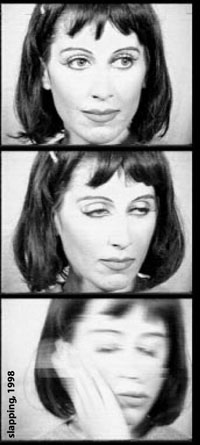
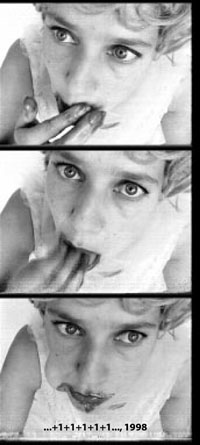
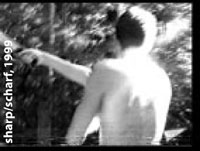


 Chantal
Michel, CH : "Sorry guys", 12 min., 1997;
Chantal
Michel, CH : "Sorry guys", 12 min., 1997;
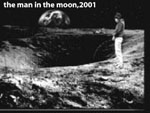
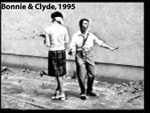

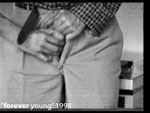 sexismus
productions, CH, "S.C.U.M, letzte Dokumente", ("S.C.U.M.
"last documents"), 35 min., 1999
sexismus
productions, CH, "S.C.U.M, letzte Dokumente", ("S.C.U.M.
"last documents"), 35 min., 1999